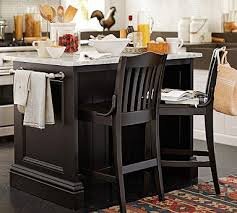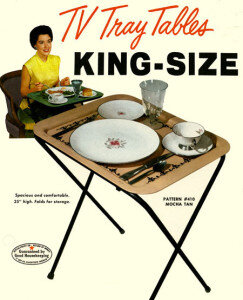Resolution More Family Dinner Part I: the Kitchen Island
 If having more meals together as a family is your New Year's Resolution, one often overlooked piece of the puzzle is the physical space where meals happen. Let's consider the kitchen island. Other than just being a place to throw keys and homework, the kitchen island in many houses and apartments has replaced the kitchen table. Granite countertops sell homes— humble tables don't.Growing up in the '70s and '80s, most Midwestern middle class kitchens I visited did not have elaborate islands or counters with stools. I remember sitting around tables. As homes generally got bigger over the last 30 years, it seems the kitchen island became standard and the eat-in kitchen disappeared.On house-calls or play-dates over the years, I've watched the parent or childcare provider standing behind the island counter preparing food and serving the children sitting at the counter. By design, the island makes line-cook and wait-staff the easiest option. And there's nothing wrong with this on occasion. But if it always happens, it robs children of the most important mealtime ingredient—a loving adult providing company and eating from the same foods (including at least one item the child generally enjoys).So, did form follow or dictate function? Were parents already standing and serving meals and needed a more efficient way to do so, or did the changing design of modern homes assist the slide of the communal family meal? Moms (both working and stay-at-home) are usually blamed for everything including obesity and the decreasing frequency of family meals, so I thought I'd implicate architects and home designers too.
If having more meals together as a family is your New Year's Resolution, one often overlooked piece of the puzzle is the physical space where meals happen. Let's consider the kitchen island. Other than just being a place to throw keys and homework, the kitchen island in many houses and apartments has replaced the kitchen table. Granite countertops sell homes— humble tables don't.Growing up in the '70s and '80s, most Midwestern middle class kitchens I visited did not have elaborate islands or counters with stools. I remember sitting around tables. As homes generally got bigger over the last 30 years, it seems the kitchen island became standard and the eat-in kitchen disappeared.On house-calls or play-dates over the years, I've watched the parent or childcare provider standing behind the island counter preparing food and serving the children sitting at the counter. By design, the island makes line-cook and wait-staff the easiest option. And there's nothing wrong with this on occasion. But if it always happens, it robs children of the most important mealtime ingredient—a loving adult providing company and eating from the same foods (including at least one item the child generally enjoys).So, did form follow or dictate function? Were parents already standing and serving meals and needed a more efficient way to do so, or did the changing design of modern homes assist the slide of the communal family meal? Moms (both working and stay-at-home) are usually blamed for everything including obesity and the decreasing frequency of family meals, so I thought I'd implicate architects and home designers too. Let's throw in furniture designers while we're at it, with the trend in tall dining tables with bar-stool height chairs where even the adults' feet don't reach the floor. What I've observed with these tables is the kids eating nearby at the kitchen island or on a child-sized picnic table separate from parents. Once parents and children are eating at different spaces it becomes easier (even automatic) to serve "kid" and "grown up" foods, with children missing out on the critical (no pressure) exposures to the very foods their parents want them to eat.Islands are fine. In fact I wish I had one. A friend of mine had me over to learn how to cook some Indian dishes while her kids sat close by at the island doing homework, chatting and enjoying their after-school snack. I also think if I had an island I wouldn't lose my keys as much, but I digress.
Let's throw in furniture designers while we're at it, with the trend in tall dining tables with bar-stool height chairs where even the adults' feet don't reach the floor. What I've observed with these tables is the kids eating nearby at the kitchen island or on a child-sized picnic table separate from parents. Once parents and children are eating at different spaces it becomes easier (even automatic) to serve "kid" and "grown up" foods, with children missing out on the critical (no pressure) exposures to the very foods their parents want them to eat.Islands are fine. In fact I wish I had one. A friend of mine had me over to learn how to cook some Indian dishes while her kids sat close by at the island doing homework, chatting and enjoying their after-school snack. I also think if I had an island I wouldn't lose my keys as much, but I digress.
Making Family Meals the Easier Option
I'm no sociologist and this is not an academic post, but I think it's worth reflecting on how our surroundings make it easier or harder for families to eat together. A popular phrase right now in public health is, "Make the healthy option the easy option." Making family meals the easier option (it's not really just easy) by addressing your physical surroundings may help with your goals of eating together more often.
- Can you trade in that tall dining table or saw off the legs?
- Can you invest in a chair that will grow with your child and provide stability and a foot rest (helps with those fidgety legs)?
- Can you plan a table nook for your kitchen remodel?
- Can you reserve the kitchen island for snacks and homework and use the dining table for dinner and weekend meals?
- Maybe buying a desk or redoing a closet for an office space can free up the dining room table?
- Can your next apartment have a dining area off the kitchen?
- Can you plan on an island big enough so that everyone can eat together?
- Can you sit around a coffee table on cushions if you don't have a table?
- Can you swing by an Ikea and get ideas for or find an affordable and compact kitchen table?
If you have a kitchen island, how is it used? What are other obstacles you face to making family meals happen?
